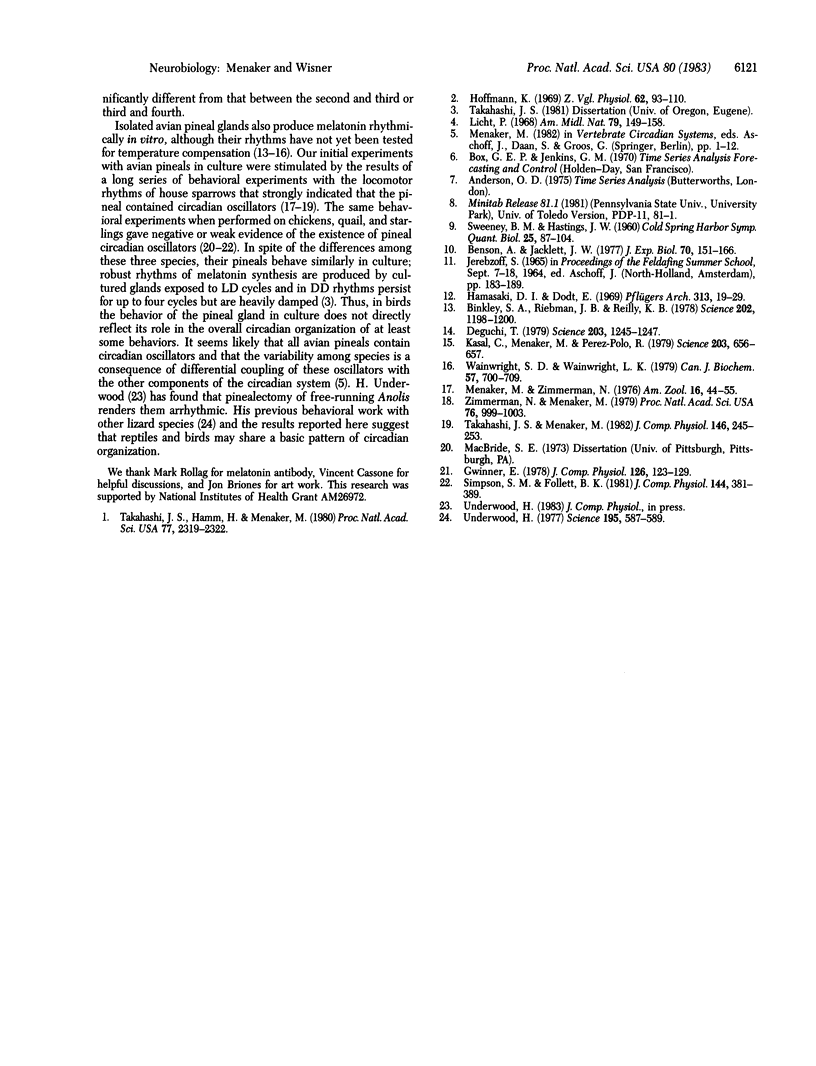Abstract
The pineal organ of the lizard Anolis carolinensis can be maintained for up to 10 days in superfused organ culture. During this time it synthesizes and releases melatonin into the medium flowing slowly over it. Collection of timed aliquots of medium and subsequent analysis for melatonin by radioimmunoassay reveal circadian rhythms of melatonin output by the isolated pineal. These rhythms persist for many cycles in constant darkness and at several constant ambient temperatures ranging from 22 to 37 degrees C. The period of the rhythm is temperature compensated (Q10 approximately equal to 1.14) and the rhythm is synchronized by light-dark cycles imposed on the cultured gland. This isolated vertebrate organ displays the three major properties of circadian systems and must therefore contain one or more circadian oscillators.
Full text
PDF


Selected References
These references are in PubMed. This may not be the complete list of references from this article.
- Binkley S. A., Riebman J. B., Reilly K. B. The pineal gland: a biological clock in vitro. Science. 1978 Dec 15;202(4373):1198–1120. doi: 10.1126/science.214852. [DOI] [PubMed] [Google Scholar]
- Deguchi T. Circadian rhythm of serotonin N-acetyltransferase activity in organ culture of chicken pineal gland. Science. 1979 Mar 23;203(4386):1245–1247. doi: 10.1126/science.424750. [DOI] [PubMed] [Google Scholar]
- Hamasaki D. I., Dodt E. Light sensitivity of the lizard's epiphysis cerebri. Pflugers Arch. 1969;313(1):19–29. doi: 10.1007/BF00586325. [DOI] [PubMed] [Google Scholar]
- Kasal C. A., Menaker M., Perez-Polo J. R. Circadian clock in culture: N-acetyltransferase activity of chick pineal glands oscillates in vitro. Science. 1979 Feb 16;203(4381):656–658. doi: 10.1126/science.569904. [DOI] [PubMed] [Google Scholar]
- SWEENEY B. M., HASTINGS J. W. Effects of temperature upon diurnal rhythms. Cold Spring Harb Symp Quant Biol. 1960;25:87–104. doi: 10.1101/sqb.1960.025.01.009. [DOI] [PubMed] [Google Scholar]
- Takahashi J. S., Hamm H., Menaker M. Circadian rhythms of melatonin release from individual superfused chicken pineal glands in vitro. Proc Natl Acad Sci U S A. 1980 Apr;77(4):2319–2322. doi: 10.1073/pnas.77.4.2319. [DOI] [PMC free article] [PubMed] [Google Scholar]
- Underwood H. Circadian organization in lizards: the role of the pineal organ. Science. 1977 Feb 11;195(4278):587–589. doi: 10.1126/science.835015. [DOI] [PubMed] [Google Scholar]
- Wainwright S. D., Wainwright L. K. Chick pineal serotonin acetyltransferase: a diurnal cycle maintained in vitro and its regulation by light. Can J Biochem. 1979 Jun;57(6):700–709. doi: 10.1139/o79-088. [DOI] [PubMed] [Google Scholar]
- Zimmerman N. H., Menaker M. The pineal gland: a pacemaker within the circadian system of the house sparrow. Proc Natl Acad Sci U S A. 1979 Feb;76(2):999–1003. doi: 10.1073/pnas.76.2.999. [DOI] [PMC free article] [PubMed] [Google Scholar]


